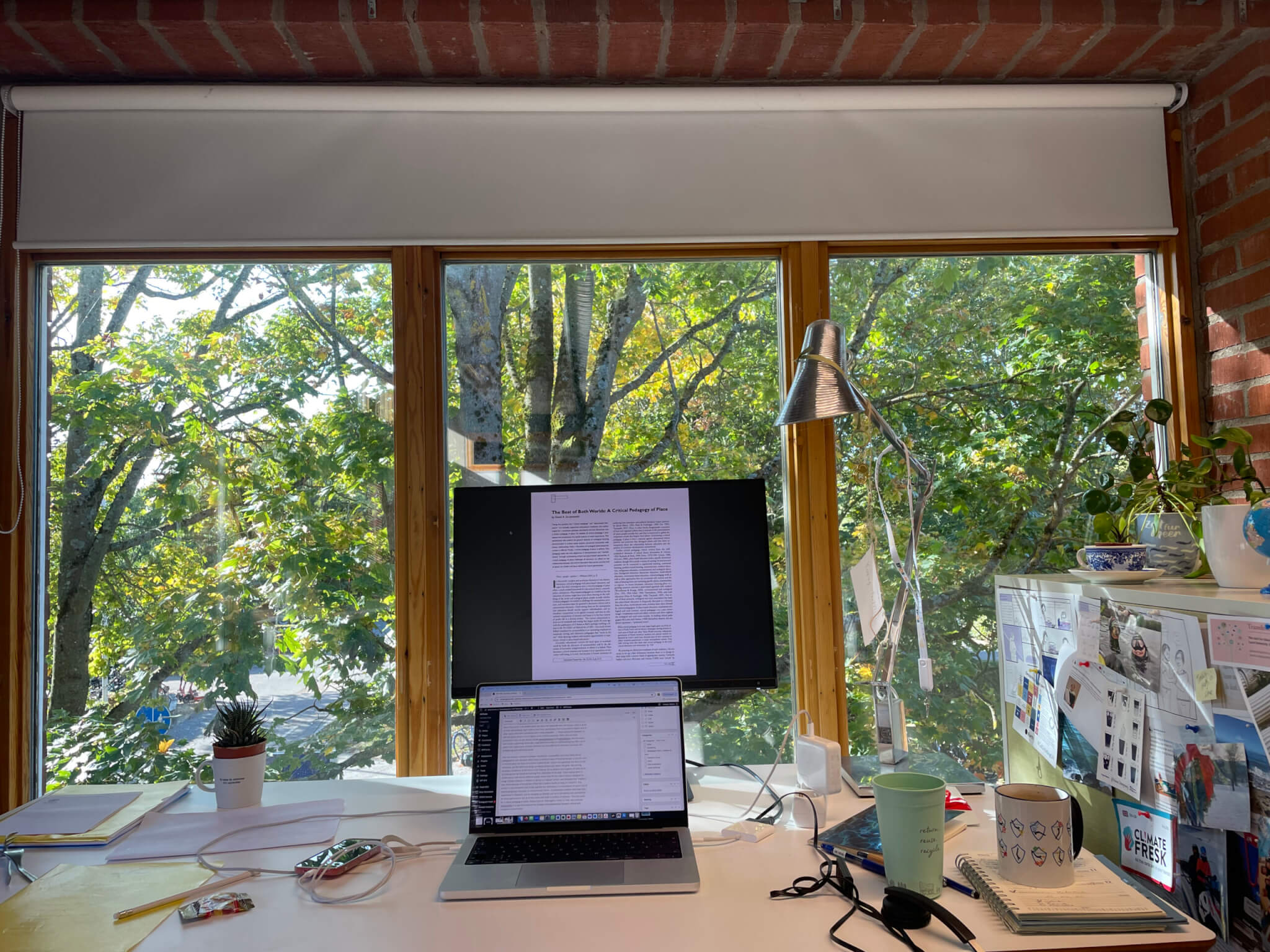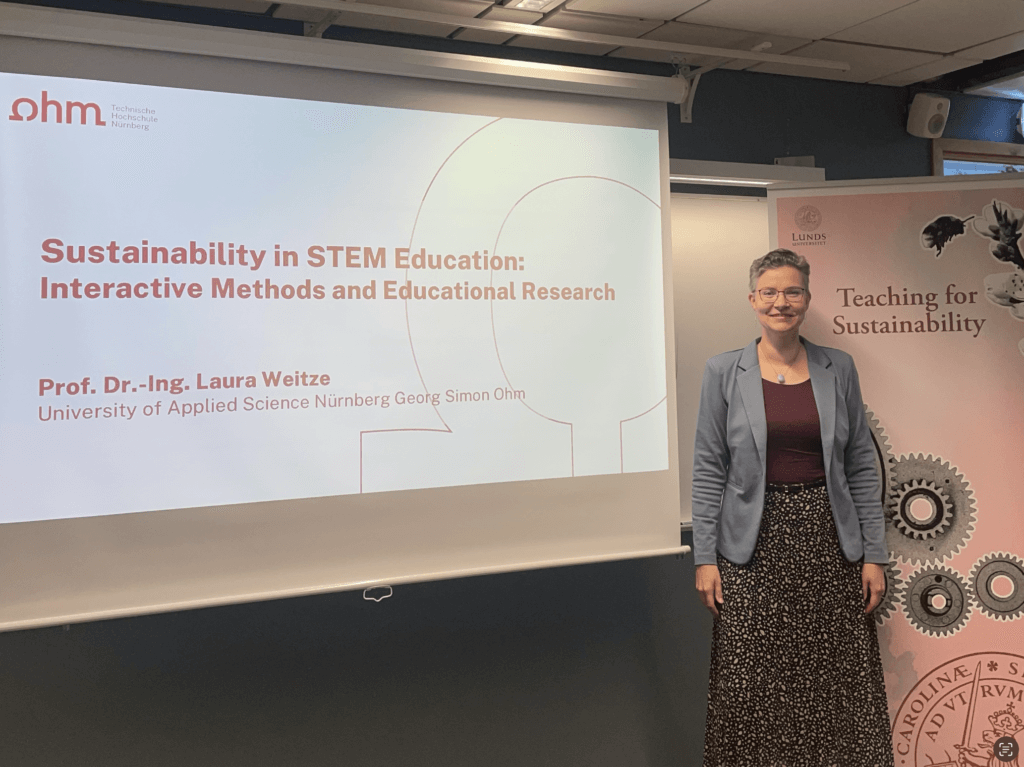
Currently reading & thinking about “The best of both worlds: A critical pedagogy of place” (Gruenewald, 2003)
I am on the fringes of a course on “Integrating Sustainability Competences in the Curriculum” that my awesome colleague Steven Curtis is currently teaching, and he asked me to read an article about “A critical pedagogy of place” (Gruenewald, 2003) and moderate a discussion about it. Below, I am summarizing the article and adding some thoughts from a recent seminar that Laura Weitze gave here at LU.
In Gruenewald (2003), two concepts are brought together: Critical pedagogy and place-based education.
- Critical pedagogy challenges the assumptions made in conventional teaching and learning, for example that students are mainly learning for themselves, that education is made for the country it is happening in, that a system of winners and losers produces the best outcomes for society.
- Place-based pedagogies aim at connecting education with the places they are happening in, so that the education actually benefits the physical location, ecological system, and local community.
Traditionally, critical pedagogy has often dealt with minorities in multicultural settings in big cities, not with rural communities, which place-based pedagogies are more often concerned with.
But people are influenced by the “temporal-spacial conditions” they are in (see also my recent post about the importance of the room), and they also have an influence back on the physical space they are in, in the widest sense (the paths we repeatedly walk will become visible in grass or snow and probably later roads or train lines, we influence how conversations happen and on what topics, how food is produced and in what ecosystem, …). These interactions between us and the spaces we are in can happen more or less purposefully. When they are more purposeful, they can and should include decolonialisation and reinhabitation. Decolonisation here means supporting historically marginalised minorities in understanding how their use of space, their experiences and their identities are controlled by the dominant narrative, and reimagining and reclaiming spaces. Reinhabiting is critically investigating and then reinventing how we live in a place.
One very obvious connection between teaching for sustainability and critical place-based pedagogies is that education often works to reinforce ways of thinking that got us into the mess in the first place: the focus on humans in general over nature more generally, the focus on the individual, and the belief that things are always going to get better and grow. Also putting ourselves, academics, at the centre of all knowing acts to devalue and suppress all other forms of knowing that we should be learning from. (Anecdote on the side: I have recently been in conversations with several different people where they felt the need to almost apologise for using Chinese medicine in addition to going to a “regular” doctor, and defended that “maybe it only works because of the placebo effect! But it doesn’t matter as long as it works?”). “Eco-justice” is one framework that brings together the dimensions of a) domination of nature and of oppressed groups of people, b) environmental racism, c) sustainable traditions that have been suppressed or forgotten, and d) changing our lifestyle such as to not destroy the environment for future generations. But all of this comes with built-in conflicts of interests: “Thus the need for a critical pedagogy of place: People must be challenged to reflect on their own concrete situationality in a way that explores the complex interrelationships between cultural and ecological environments.”
In ecological place-based education, this is done through five characteristics: a) it is shaped by the place itself, b) it is multidisciplinary, c) it is experiential, d) it is more than “learning to earn”, and e) it connects self, community, and place. This is in conflict with the big trend in education worldwide (for example expressed in the Bologna process), that is standardising educations and degrees in order to make students competitive worldwide, which means dismissing the place as educational context and influence. But by including work in the local community, for example, we can enrich student experiences and engagement and include goals beyond just being competitive on the global market (which, I would argue, being able to work with contexts would even contribute to, too!). Also, building and using connectedness to local nature first (even the small area around your tree house!) and practising exploration can help build empathy and respect for global problems: “If we want children to flourish, to be- come truly empowered, then let us allow them to love the earth before we ask them to save it”
Bringing all of this together, “A critical pedagogy of place aims to (a) identify, recover, and create material spaces and places that teach us how to live well in our total environments (reinhabitation); and (b) identify and change ways of thinking that injure and exploit other people and places (decolonization).” This is a call to action for teachers in their own practice, to include the social and ecological contexts of where we live, work, and teach, but also a wider responsibility of policy makers and educational researchers to create frameworks in which this is supported. It is a call to action for all of us, “challenging each other to read the texts of our own lives and to ask constantly what needs to be transformed and what needs to be conserved”.
Phew, done! Not an easy read! But it sparked a lot of thoughts in me relating to two other blog posts I was trying to write on the side that will now end up here:
The current iEarth Journal Club paper on “Self-guided field trips allow flexibility in undergraduate student introductory field experiences” (Shinneman et al., 2020). There, they argue that field trips are resource intensive and often come with high carbon footprints. As alternative, they present asynchronous, self-guided field trips in a fly-over app as an alternative to guided, actual trips to the same field site. They conclude that students learn as much in the self-guided, virtual field trip as in the actual field trip (they just perceive it as slightly less), and they appreciate the flexibility.
Already in the draft for that blog post, I was adding suggestions for what we could do in terms of hyper-local field courses, because although it sounds like Shinneman et al. (2020)’s field trip are a good alternative to an existing one, I like the idea of making the most out of wherever students are in order to get them to connect disciplinary content to their own, real-life experiences, even when, at the time of writing about virtual field courses, we were in covid-19 lockdown in Germany. My favourite method was, and still is, this one:
And then, this week, LAura Weitze from the University of Applied Sciences Nüremberg came to visit the Teaching for Sustainability initiative. She gave a workshop on "Sustainability in STEM education: Interactive methods and educational research" and focussed on the "walk and talk" method, that she uses in coaching and teaching. For this, she uses synchronous (audio file with some input that people listen to while walking and then discuss) or asynchronous (students get an audio file for a specific route with "stand here for 2 minutes and notice vibrations" instructions -- very similar to what we did with our "mobile adventure for coastal protection") versions. Both have the effect of getting people outside and moving, and maybe make them notice their environment in different ways, especially the latter one.

Laura Weitze presenting at Lund University, Sweden
And I am wondering how to connect asynchronous experiences, be it the "active lunch break" or the guided walks as above, with more sustainability, and a critical pedagogy of place. Maybe it is a reflexion question on how the disciplinary content students are looking at (the vibrations of a subway as in Laura's case, or the flow pattern in a gutter in mine) is related to societal, ecological, and economical questions? In Laura's case, maybe it is about affordable public transport as desirable for ecological and work-life balance reasons, but with implications for quality of life of people who live above a subway line, maybe the vibrations are also causing damages on buildings, ... In my case, maybe it is about how rainwater catchment is useful to mitigate dry periods, but how cigarette butts and micro plastic are washed down the drain with them, contaminating the water, but sieves would clog up all the time and cleaning the water would be expensive. Or any number of other things that might come up once we think about it.
And then looking at a critical pedagogy of place that "aims to (a) identify, recover, and create material spaces and places that teach us how to live well in our total environments (reinhabitation); and (b) identify and change ways of thinking that injure and exploit other people and places (decolonization)." -- maybe in my case, instead of surface water drain pipes, we could imagine have open little rivers in which plants grow and animals live, which would improve water quality (and maybe that reduces the need for treatment plants that are typically located in poor neighbourhoods) and also include health benefits for people (because looking at water is gooooood for you), especially in inner cities where there is little green and little water. Of course, there is also little space to do this, but I am shooting from the hip here. But generally, I think adding these extra reflexion questions could be fun, and maybe be a step in the right direction!
Gruenewald, D. A. (2003). The best of both worlds: A critical pedagogy of place. Educational researcher, 32(4), 3-12.
Shinneman, A. L., Loeffler, S., & Myrbo, A. E. (2020). Self-guided field trips allow flexibility in undergraduate student introductory field experiences. Journal of Geoscience Education, 68(4), 371-379.